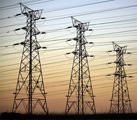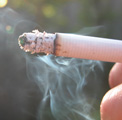


Three-quarters of the Universe is dark energy, but nobody knows what it is. Is it an unknown form of energy that fills space, or an illusion caused by extra dimensions of space? Or is it just a flaw in Einstein’s theory of gravity? Proven techniques for investigating these questions are being refined, while new techniques are beginning to be applied to one of the most pressing problems in 21st-century physics. A series of articles sheds light on this mysterious phenomena. Part 1 discusses supernovae as standard candles, Part 2 explores baryon acoustic oscillation and Part 3 looks at gravitational lensing.
 The National Cancer Institute has awarded UC Berkeley $15.7 million over five years to allow physical scientists and engineers to open a new front in the war on cancer. UC Berkeley's Physical Sciences-Oncology Center, a collaboration with Berkeley Lab, UC San Francisco, and San Francisco's Helen Diller Comprehensive Cancer Center, is one of 12 centers announced Monday "to bring new perspectives to the mechanisms of cancer." Lab researchers include Jan Liphardt (principal investigator), Joe Gray, Jay Groves, James Sethian, and Mina Bissell. More>
The National Cancer Institute has awarded UC Berkeley $15.7 million over five years to allow physical scientists and engineers to open a new front in the war on cancer. UC Berkeley's Physical Sciences-Oncology Center, a collaboration with Berkeley Lab, UC San Francisco, and San Francisco's Helen Diller Comprehensive Cancer Center, is one of 12 centers announced Monday "to bring new perspectives to the mechanisms of cancer." Lab researchers include Jan Liphardt (principal investigator), Joe Gray, Jay Groves, James Sethian, and Mina Bissell. More>
 In The News: Mining Fool's Gold for Solar Cells
In The News: Mining Fool's Gold for Solar Cells [Technology Review] Fool's gold, also called pyrite or iron sulfide, can be unearthed just about anywhere, from the hills of California to the villages of Yunnan Province in China. But instead of digging pyrite up, Berkeley Lab researcher Cyrus Wadia is making pure nanoparticles of the compound from iron and sulfur salts in his lab. His ultimate goal is to turn Fool's gold into real treasure: an inexpensive solar cell. More>
 UC Berkeley's best and brightest are often asked to share their insights at the White House, on Wall Street and with the media worldwide. Now, they are furthering that conversation in a new format — The Berkeley Blog. The blog features experts fielding a wide spectrum of questions about the hottest current events. The blog appears to be the first such enterprise based at a major university in the United States. Lab researchers include Interim Lab Director Paul Alivisatos, Jamie Cate and David Shaffer (Physical Biosciences), Michael Eisen (Genomics), Inez Fung (Earth Sciences), William Jagust and Randy Schekman (Life Sciences), Rich Muller (Physics), William Nazaroff (EETD), and David Patterson (Computing Sciences). More>
UC Berkeley's best and brightest are often asked to share their insights at the White House, on Wall Street and with the media worldwide. Now, they are furthering that conversation in a new format — The Berkeley Blog. The blog features experts fielding a wide spectrum of questions about the hottest current events. The blog appears to be the first such enterprise based at a major university in the United States. Lab researchers include Interim Lab Director Paul Alivisatos, Jamie Cate and David Shaffer (Physical Biosciences), Michael Eisen (Genomics), Inez Fung (Earth Sciences), William Jagust and Randy Schekman (Life Sciences), Rich Muller (Physics), William Nazaroff (EETD), and David Patterson (Computing Sciences). More>
 DOE Update: $3.4 Billion Funding For Transition to Smart Energy Grid
DOE Update: $3.4 Billion Funding For Transition to Smart Energy GridSpeaking at Florida Power and Light’s DeSoto Next Generation Solar Energy Center, President Barack Obama yesterday announced the largest single energy grid modernization investment in U.S. history, funding a broad range of technologies that will spur the nation’s transition to a smarter, stronger, more efficient and reliable electric system. The end result will promote energy-saving choices for consumers, increase efficiency, and foster the growth of renewable energy sources like wind and solar. More>
 To diminish fire and health hazards, employees who smoke are reminded to adhere to the Lab’s policy on smoking. Smoking is only permitted outdoors on areas paved with asphalt, brick or concrete, and at least 20 feet away from building entrances, operable windows and air intakes. No smoking is allowed in Lab vehicles, on decks or stairs, in areas with vegetation, or any areas posted as "No Smoking." Smokers are responsible for the safe disposal of their cigarettes and should use ash cans to make sure materials are properly extinguished. Request an ash cans by calling x6274. Go here to view the full policy.
To diminish fire and health hazards, employees who smoke are reminded to adhere to the Lab’s policy on smoking. Smoking is only permitted outdoors on areas paved with asphalt, brick or concrete, and at least 20 feet away from building entrances, operable windows and air intakes. No smoking is allowed in Lab vehicles, on decks or stairs, in areas with vegetation, or any areas posted as "No Smoking." Smokers are responsible for the safe disposal of their cigarettes and should use ash cans to make sure materials are properly extinguished. Request an ash cans by calling x6274. Go here to view the full policy.
Today at Berkeley Lab is produced by Public Affairs' Communications Group